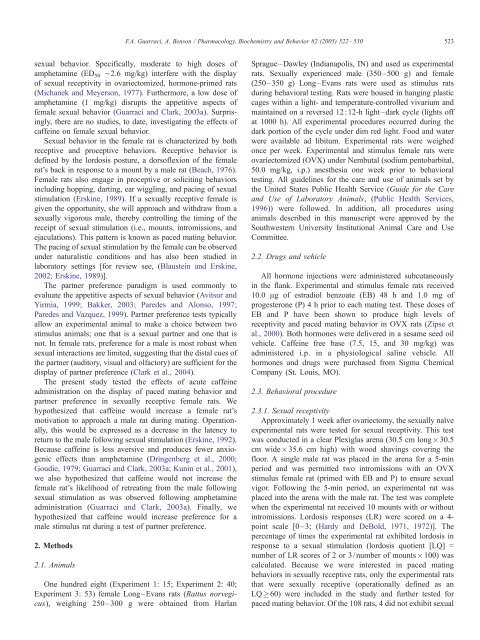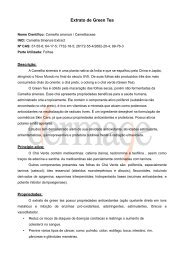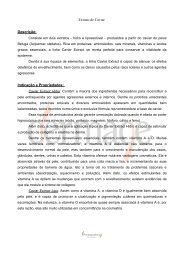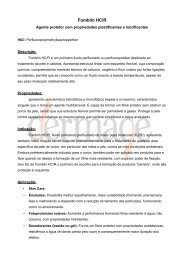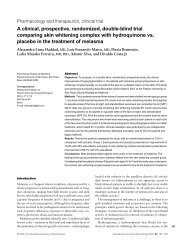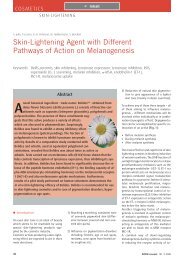''Coffee, Tea and Me'': Moderate doses of caffeine affect ... - Dermage
''Coffee, Tea and Me'': Moderate doses of caffeine affect ... - Dermage
''Coffee, Tea and Me'': Moderate doses of caffeine affect ... - Dermage
You also want an ePaper? Increase the reach of your titles
YUMPU automatically turns print PDFs into web optimized ePapers that Google loves.
sexual behavior. Specifically, moderate to high <strong>doses</strong> <strong>of</strong><br />
amphetamine (ED 50 ¨2.6 mg/kg) interfere with the display<br />
<strong>of</strong> sexual receptivity in ovariectomized, hormone-primed rats<br />
(Michanek <strong>and</strong> Meyerson, 1977). Furthermore, a low dose <strong>of</strong><br />
amphetamine (1 mg/kg) disrupts the appetitive aspects <strong>of</strong><br />
female sexual behavior (Guarraci <strong>and</strong> Clark, 2003a). Surprisingly,<br />
there are no studies, to date, investigating the effects <strong>of</strong><br />
<strong>caffeine</strong> on female sexual behavior.<br />
Sexual behavior in the female rat is characterized by both<br />
receptive <strong>and</strong> proceptive behaviors. Receptive behavior is<br />
defined by the lordosis posture, a dors<strong>of</strong>lexion <strong>of</strong> the female<br />
rat’s back in response to a mount by a male rat (Beach, 1976).<br />
Female rats also engage in proceptive or soliciting behaviors<br />
including hopping, darting, ear wiggling, <strong>and</strong> pacing <strong>of</strong> sexual<br />
stimulation (Erskine, 1989). If a sexually receptive female is<br />
given the opportunity, she will approach <strong>and</strong> withdraw from a<br />
sexually vigorous male, thereby controlling the timing <strong>of</strong> the<br />
receipt <strong>of</strong> sexual stimulation (i.e., mounts, intromissions, <strong>and</strong><br />
ejaculations). This pattern is known as paced mating behavior.<br />
The pacing <strong>of</strong> sexual stimulation by the female can be observed<br />
under naturalistic conditions <strong>and</strong> has also been studied in<br />
laboratory settings [for review see, (Blaustein <strong>and</strong> Erskine,<br />
2002; Erskine, 1989)].<br />
The partner preference paradigm is used commonly to<br />
evaluate the appetitive aspects <strong>of</strong> sexual behavior (Avitsur <strong>and</strong><br />
Yirmia, 1999; Bakker, 2003; Paredes <strong>and</strong> Alonso, 1997;<br />
Paredes <strong>and</strong> Vazquez, 1999). Partner preference tests typically<br />
allow an experimental animal to make a choice between two<br />
stimulus animals; one that is a sexual partner <strong>and</strong> one that is<br />
not. In female rats, preference for a male is most robust when<br />
sexual interactions are limited, suggesting that the distal cues <strong>of</strong><br />
the partner (auditory, visual <strong>and</strong> olfactory) are sufficient for the<br />
display <strong>of</strong> partner preference (Clark et al., 2004).<br />
The present study tested the effects <strong>of</strong> acute <strong>caffeine</strong><br />
administration on the display <strong>of</strong> paced mating behavior <strong>and</strong><br />
partner preference in sexually receptive female rats. We<br />
hypothesized that <strong>caffeine</strong> would increase a female rat’s<br />
motivation to approach a male rat during mating. Operationally,<br />
this would be expressed as a decrease in the latency to<br />
return to the male following sexual stimulation (Erskine, 1992).<br />
Because <strong>caffeine</strong> is less aversive <strong>and</strong> produces fewer anxiogenic<br />
effects than amphetamine (Dringenberg et al., 2000;<br />
Goudie, 1979; Guarraci <strong>and</strong> Clark, 2003a; Kunin et al., 2001),<br />
we also hypothesized that <strong>caffeine</strong> would not increase the<br />
female rat’s likelihood <strong>of</strong> retreating from the male following<br />
sexual stimulation as was observed following amphetamine<br />
administration (Guarraci <strong>and</strong> Clark, 2003a). Finally, we<br />
hypothesized that <strong>caffeine</strong> would increase preference for a<br />
male stimulus rat during a test <strong>of</strong> partner preference.<br />
2. Methods<br />
2.1. Animals<br />
F.A. Guarraci, A. Benson / Pharmacology, Biochemistry <strong>and</strong> Behavior 82 (2005) 522–530 523<br />
One hundred eight (Experiment 1: 15; Experiment 2: 40;<br />
Experiment 3: 53) female Long–Evans rats (Rattus norvegicus),<br />
weighing 250–300 g were obtained from Harlan<br />
Sprague–Dawley (Indianapolis, IN) <strong>and</strong> used as experimental<br />
rats. Sexually experienced male (350–500 g) <strong>and</strong> female<br />
(250–350 g) Long–Evans rats were used as stimulus rats<br />
during behavioral testing. Rats were housed in hanging plastic<br />
cages within a light- <strong>and</strong> temperature-controlled vivarium <strong>and</strong><br />
maintained on a reversed 12:12-h light–dark cycle (lights <strong>of</strong>f<br />
at 1000 h). All experimental procedures occurred during the<br />
dark portion <strong>of</strong> the cycle under dim red light. Food <strong>and</strong> water<br />
were available ad libitum. Experimental rats were weighed<br />
once per week. Experimental <strong>and</strong> stimulus female rats were<br />
ovariectomized (OVX) under Nembutal (sodium pentobarbital,<br />
50.0 mg/kg, i.p.) anesthesia one week prior to behavioral<br />
testing. All guidelines for the care <strong>and</strong> use <strong>of</strong> animals set by<br />
the United States Public Health Service (Guide for the Care<br />
<strong>and</strong> Use <strong>of</strong> Laboratory Animals, (Public Health Services,<br />
1996)) were followed. In addition, all procedures using<br />
animals described in this manuscript were approved by the<br />
Southwestern University Institutional Animal Care <strong>and</strong> Use<br />
Committee.<br />
2.2. Drugs <strong>and</strong> vehicle<br />
All hormone injections were administered subcutaneously<br />
in the flank. Experimental <strong>and</strong> stimulus female rats received<br />
10.0 Ag <strong>of</strong> estradiol benzoate (EB) 48 h <strong>and</strong> 1.0 mg <strong>of</strong><br />
progesterone (P) 4 h prior to each mating test. These <strong>doses</strong> <strong>of</strong><br />
EB <strong>and</strong> P have been shown to produce high levels <strong>of</strong><br />
receptivity <strong>and</strong> paced mating behavior in OVX rats (Zipse et<br />
al., 2000). Both hormones were delivered in a sesame seed oil<br />
vehicle. Caffeine free base (7.5, 15, <strong>and</strong> 30 mg/kg) was<br />
administered i.p. in a physiological saline vehicle. All<br />
hormones <strong>and</strong> drugs were purchased from Sigma Chemical<br />
Company (St. Louis, MO).<br />
2.3. Behavioral procedure<br />
2.3.1. Sexual receptivity<br />
Approximately 1 week after ovariectomy, the sexually naïve<br />
experimental rats were tested for sexual receptivity. This test<br />
was conducted in a clear Plexiglas arena (30.5 cm long 30.5<br />
cm wide 35.6 cm high) with wood shavings covering the<br />
floor. A single male rat was placed in the arena for a 5-min<br />
period <strong>and</strong> was permitted two intromissions with an OVX<br />
stimulus female rat (primed with EB <strong>and</strong> P) to ensure sexual<br />
vigor. Following the 5-min period, an experimental rat was<br />
placed into the arena with the male rat. The test was complete<br />
when the experimental rat received 10 mounts with or without<br />
intromissions. Lordosis responses (LR) were scored on a 4point<br />
scale [0–3; (Hardy <strong>and</strong> DeBold, 1971, 1972)]. The<br />
percentage <strong>of</strong> times the experimental rat exhibited lordosis in<br />
response to a sexual stimulation (lordosis quotient [LQ] =<br />
number <strong>of</strong> LR scores <strong>of</strong> 2 or 3/number <strong>of</strong> mounts 100) was<br />
calculated. Because we were interested in paced mating<br />
behaviors in sexually receptive rats, only the experimental rats<br />
that were sexually receptive (operationally defined as an<br />
LQ 60) were included in the study <strong>and</strong> further tested for<br />
paced mating behavior. Of the 108 rats, 4 did not exhibit sexual


